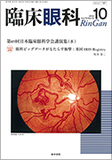Japanese
English
- 有料閲覧
- Abstract 文献概要
- 1ページ目 Look Inside
- 参考文献 Reference
要約 目的:糖尿病黄斑浮腫(DME)に対して光干渉断層計(OCT)による形態分類を行い,その分類が治療選択に有用であるかを検討した。
対象と方法:DMEを呈した非増殖網膜症28例36眼に対して,SD-OCTを用いた形態分類を行い,その結果により網膜光凝固またはトリアムシノロンテノン囊下注射(STTA)を選択した。
結果:OCTの網膜厚マップ,Bスキャン,3次元画像から浮腫の状態を3つのタイプに分類した。山形で浮腫のピークが中心小窩外にあるタイプは毛細血管瘤が浮腫の主な原因と考えられ,毛細血管瘤に対する直接凝固を含む光凝固が有効であった。山形で浮腫のピークが中心小窩内にあるタイプは中心小窩内に浮腫の主な原因があり,STTAが有効であった。中心小窩を環状にとり囲むタイプは主に黄斑部周囲の毛細血管からの漏出と考えられ,浮腫の部位の局所光凝固が有効であった。
結論:DMEをOCT像で分類することは治療選択に有用であると思われた。
Abstract Purpose: To report classification of diabetic macular edema based on findings by optical coherence tomography(OCT)and outcome of treatment in accordance to the classification.
Cases and Method: This study was made on 36 eyes of 28 cases of nonproliferative diabetic retinopathy with macular edema. SD-OCT was used to classify the macular edema. The eyes were treated either by retinal photocoagulation or subtenon infusion of triamcinolone acetonide(STTA).
Results: Macular edema was classified into 3 types:cone-shaped edema with the peak out of the fovea(type Ⅰ), cone-shaped edema with the peak in the foveola(type Ⅱ), and ring-shaped edema surrounding the foveola(type Ⅲ). Type Ⅰ was mainly due to microaneurysms and responded to photocoagulation to them. The cause of type Ⅱ was located in the foveola and responded to STTA. Type Ⅲ appeared to be due to leakage from capillaries and responded to focal photocoagulation.
Conclusion: Classification of diabetic macular edema based on OCT findings was useful in the choice of treatment.

Copyright © 2016, Igaku-Shoin Ltd. All rights reserved.


